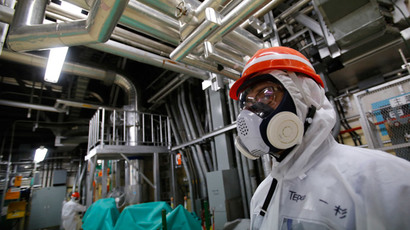US firm hired to save Fukushima from 400k tons of radioactive water

TEPCO, the company in charge of the damaged Fukushima nuclear power plant, cannot filter a dangerous radioactive isotope out of about 400,000 metric tons of water before returning it to the sea, and has contracted with a US company for a second system.
In April, Tokyo Electric Power Company (TEPCO) launched a contaminated water management system at the crippled Fukushima nuclear plant, which was designed to pump groundwater into tanks before it passes through the premises of the plant. After checking the water’s quality it would be dumped into the ocean.
But “Japan’s crippled nuclear plant is bleeding hazardous radioactive water at a mind-staggering rate,” KPLU reported. “Officials at Fukushima Daiichi are filling 27-foot-tall tanks nearly every other day.”
The filtration at Fukushima is used to remove Strontium-90 (Sr-90), a by-product of the fission of uranium and plutonium in nuclear reactors, from the plant’s water before it is dumped in the ocean. Sr-90 is found in waste from nuclear reactors, and is considered one of the more hazardous constituents of nuclear wastes, the US Environmental Protection Agency said. It can also contaminate reactor parts and fluids. The radioactive isotope is referred to as a "bone seeker." Internal exposure to Sr-90 is linked to bone cancer, cancer of the soft tissue near the bone and leukemia.
At the site, Toshiba Corp's Advanced Liquid Processing System (ALPS), which was designed to remove the most dangerous nuclides from water, has been in intermittent operation for the past two years, Reuters reported. Two of the three ALPS units, each capable of processing 250 tons of water per day, were taken offline in May after high levels of calcium were found in the water leaving the system. One of those units resumed processing water on Tuesday. The third processor, taken offline in April after filters and gaskets deteriorated due to radiation exposure, came back online on May 23, Bloomberg reported.
The new TEPCO contract with US-based Kurion Inc. provides for a mobile water-filtration system mounted on trucks to be used alongside the ALPS processors, which are designed to decontaminate 62 of the 63 radioisotopes present in tank water to prepare it for release into the environment, Kurion said. The truck-based filters will focus solely on strontium reduction.
“Strontium is the greatest emitter of radiation impacting site dose-rates,” Kurion founder and President John Raymont said in a statement. “So reducing strontium in tank water stored on-site will significantly improve worker safety and reduces the risk to the surrounding environment.”
Kurion’s system will filter about 79,000 gallons of water per day, however will not totally clean up the water. “But most of the highly radioactive stuff will be taken out,” KPLU reported. Currently, the tanks at Fukushima store approximately 400,000 metric tons of radioactive water, and that volume is expanding at 400 tons per day, Kurion said.
The US-based company, whose motto is “Isolating waste from the environment,” has been working with TEPCO since 2011, when “cesium… presented the greatest immediate threat to human safety and the environment,” Raymont said in the statement.
After the tsunami and earthquake struck Japan on March 11, 2011, three nuclear reactors at the plant suffered nuclear meltdowns, causing radioactive fallout in the region. The catastrophe was the world’s worst nuclear disaster since Chernobyl in 1986.
Radiation from the disaster has already affected more than just Japan. In November, the National Oceanic and Atmospheric Administration (NOAA) announced over a million tons of Fukushima debris could be just 1,700 miles off the American coast, floating between Hawaii and California. In April, researchers at Oregon State University reported radiation levels in some albacore tuna caught off the coast of the Pacific Northwest have tripled since the disaster.
Kurion also hopes that it can use the same system it will employ at Fukushima closer to home.
"This is going to demonstrate for them in real world, in real time whether or not this technology really works and give them a real opportunity to think about whether they can deploy the same concept for the tank farm here at Hanford," Raymont said to KPLU, referring to America’s most-contaminated nuclear facility in Washington state.













